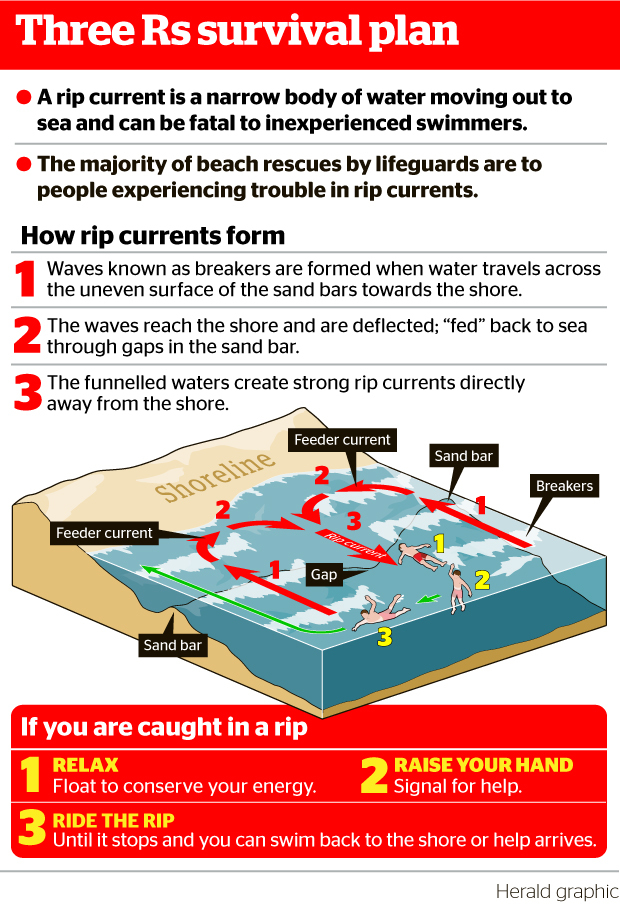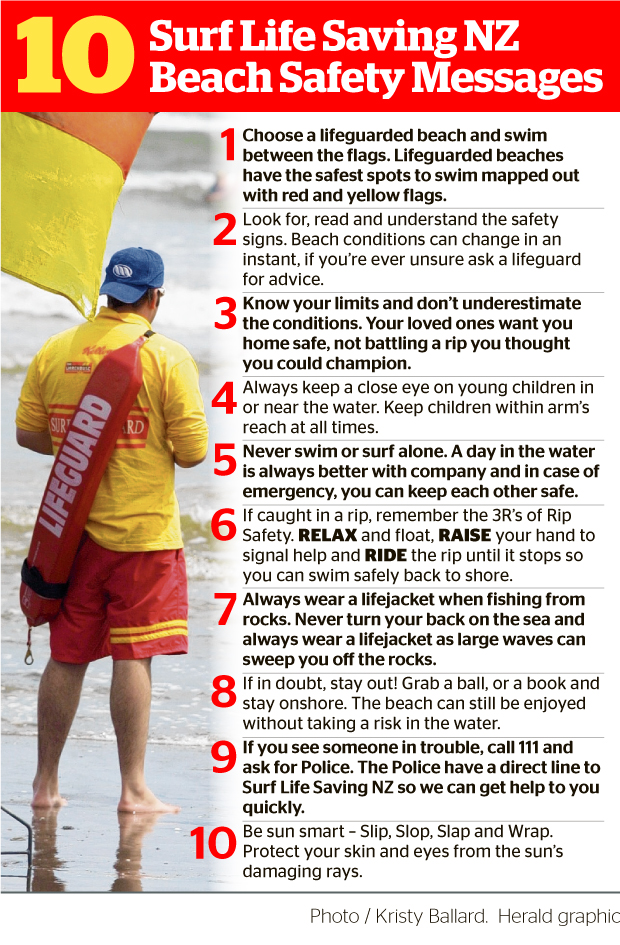
A patch of calm water in between choppy waves may look like an inviting spot to swim, but it's probably the most dangerous thing you'll encounter at the beach: a rip.
Anyone who struggles against a rip and tries to swim back to shore will quickly become exhausted and the fatigue will increase the risk of drowning.
There are many signs to look out for when assessing whether it's safe to swim at an unpatrolled beach.
WHAT IS A RIP?
A rip current is a narrow body of water moving out to sea. They're formed by the interaction between the sea and the shore. As waves break they generate currents that flow along the shoreline and back out to sea.
HOW TO SPOT A RIP
The easiest way to spot a rip is looking for calm stretches of water between waves.
The water may be deeper and darker with fewer waves breaking in among areas of white water, like a river within the sea.
If you can see a ripple pattern in the sand beneath your feet in the water, this may be a sign of a rip.
Rip currents are also common in areas with sand bars, piers, jetties and anything else that sticks out from the beach.
WHAT TO DO
Three Rs: Relax, Raise and Ride:
RELAX: Stay calm, relax and float on your back. The rip current will not pull you under the water.
RAISE: Raise your hand and keep it in the air to try and attract help from surf lifesavers, surfers or someone on the beach who can help.
RIDE: Ride the rip. Remain floating until the current weakens. Many rips will circulate and bring you back into shallower waters closer to the shore where you may be able to stand and walk out of the water.
When the current has subsided, and only if you are sure you can swim to the nearest point on the shore, should you attempt to swim to safety.

WHAT NOT TO DO
Don't try to swim against the current.
Fight the urge to swim back to shore because this will use energy you need to stay afloat until help arrives.
No one is stronger than a rip, not even an Olympic swimmer can beat a rip.
Most people can float for a lot longer than they can swim.
WHAT ARE THE DANGERS?
The rip won't drag you under the water, but it will carry you for some time.
The biggest danger is exhaustion and taking on water. If you float on your back you will conserve energy and have a greater chance of being able to swim back to shore.
Outdoor education student Sam and librarian Donna were enjoying themselves at the beach when they became caught in a rip.
"We were just enjoying having fun in the waves, cooling down and then a couple of big waves came in and before we knew it we were being sucked out in a rip," said Donna.
Sam said it happened so quickly.
"One minute my feet were on the ground, [I] went under a wave and [the next minute] I couldn't touch it and my head was going under water."
After initially trying to fight it Sam started to relax - one of the three key things to do in a rip.
"Initially I tried to swim against it but then I remembered I needed to relax and conserve my energy, so I floated on my back and slowly rode the rip out and then got washed back in with some waves."
"It's not until you're actually put in that moment then you really understand fully what it's capable of."
Surfer Mark Stirling was on the beach with a friend when he noticed three swimmers in trouble about 60m offshore.
"We had to make a split-second decision on whether or not we were going to attempt the rescue or try to find more help. With a quick assessment of the beach we released we were the only two people who had noticed so we ran down the beach and into the water."
Stirling said the surf was 2-3m and there was a moment of doubt in his mind about whether he had enough energy to reach them.
"We persevered and got out to the swimmers; they were in a bit of a state. There [were] three of them, they only had their shorts and T-shirts on with a small kid's boogie board between them. They were tired."
Stirling and his friend got the trio to hold on to their leg ropes and "we sort of bunny-hopped them in to the beach through the breakers".
"Once we got on to the beach I think the swimmers quickly realised they underestimated the power of the water.
"They possibly got swept into the rip with what's called a sweep — a sideways current.
"I really believe another two or three minutes it could have had a really different outcome."

Pilates and physio trainer David Toomey realised something was wrong when he swam about 20 strokes but didn't get anywhere.
He had been swimming out to a buoy but decided to head back to the shore.
"I turned around and started to make my way back in, did about 20 strokes and turned around and realised I was still at the same place and I realised I was caught in a rip."
Toomey acted like many who suddenly realise they are in trouble: "I started to freak out".
"I started to thrash through the water. I could feel my breath getting really shallow, I started panicking. I was getting nowhere."
Fortunately he was able to swim to some rocks.
"I sat down and could feel there was a mixture of salt water, sweat and tears. I was completely overwhelmed and I was so happy to be out of the water and be safe, but still sort of raw and fresh from being in such a powerless and crazy situation."













